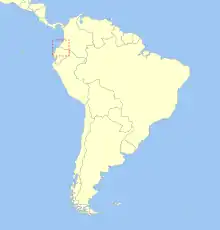Carchi Andes toad
The Carchi Andes toad (Rhaebo colomai) is a species of toad endemic to the western slopes of the Andes in northern Ecuador and southern Colombia.[2][3] It is listed as an endangered species due to a restricted range and habitat loss.[1]
| Carchi Andes toad | |
|---|---|
| Scientific classification | |
| Domain: | Eukaryota |
| Kingdom: | Animalia |
| Phylum: | Chordata |
| Class: | Amphibia |
| Order: | Anura |
| Family: | Bufonidae |
| Genus: | Rhaebo |
| Species: | R. colomai |
| Binomial name | |
| Rhaebo colomai (Hoogmoed, 1985) | |
 | |
| Geographic range in South America | |
| Synonyms | |
|
Andinophryne colomai Hoogmoed, 1985 | |
Description
Rhaebo colomai are medium-sized toads: males measure 33–38 mm (1.3–1.5 in) and females 55–59 mm (2.2–2.3 in) in snout–vent length.[3][4]
Habitat and conservation
This species is known only from three locations: the type locality ("Cabacera del Rio Baboso, cerca a Lita', Carchi Province, Ecuador"), one other locality close by in the province of Carchi, in the northwestern Andes of Ecuador, and one locality on the Colombian Massif in the Nariño Department. It has been recorded from 1,180 to 1,500 m asl.[3][4][5]
The holotype was collected on a branch some 50 cm above the ground in the forest of a small creek at night.[6] A male was collected at night sitting on a tree trunk in a creek, while a female was collected in the afternoon on the forest floor near a creek. The stomach of a female was crammed with ants.[7]
The type locality has been severely impacted by habitat destruction as a result of agriculture and logging. In addition, spraying of herbicides in Colombia to control crops is polluting the species' habitat. An unknown intrinsic factor may also be responsible for the species' scarcity.[1]
References
- IUCN SSC Amphibian Specialist Group (2018). "Rhaebo colomai". IUCN Red List of Threatened Species. 2018: e.T54462A85856993. doi:10.2305/IUCN.UK.2018-1.RLTS.T54462A85856993.en. Retrieved 18 November 2021.
- Frost, Darrel R. (2014). "Rhaebo colomai (Hoogmoed, 1985)". Amphibian Species of the World: an Online Reference. Version 6.0. American Museum of Natural History. Retrieved 17 September 2015.
- Ron, Santiago R.; Mueses-Cisneros, Jonh Jairo; Gutiérrez-Cárdenas, Paul David Alfonso; Rojas-Rivera, Alejandra; Lynch, Ryan L.; Rocha, Carlos F. Duarte; Galarza, Gabriela (2015). "Systematics of the endangered toad genus Andinophryne (Anura: Bufonidae): phylogenetic position and synonymy under the genus Rhaebo". Zootaxa. 3947 (3): 347–366. doi:10.11646/zootaxa.3947.3.3. PMID 25947741.
- Coloma, L. A.; Frenkel, C.; Félix-Novoa, C. & Quiguango-Ubillús, A. (2015). "Rhaebo colomai". Ron, S. R., Guayasamin, J. M., Yanez-Muñoz, M. H., Merino-Viteri, A., Ortiz, D. A. y Nicolalde, D. A. 2014. AmphibiaWebEcuador. Version 2014.0. Museo de Zoología, Pontificia Universidad Católica del Ecuador (QCAZ). Archived from the original on 21 March 2015. Retrieved 17 September 2015.
- Acosta-Galvis, A.R. (2015). "Rhaebo colomai (Hoogmoed, 1985)". Lista de los Anfibios de Colombia V.05.2015. www.batrachia.com. Retrieved 17 September 2015.
- Hoogmoed, Marinus S. (1985). "A new genus of toads (Amphibia: Anura: Bufonidae) from the Pacific slopes of the Andes in Northern Ecuador and Southern Colombia, with the description of two new species" (PDF). Zoologische Mededelingen. Leiden. 59 (22): 251–274. ISSN 0024-0672. Retrieved 6 February 2014.
- Hoogmoed, Marinus S. (1989). "On the identity of some toads of the genus Bufo from Ecuador, with additional remarks on Andinophryne colomai Hoogmoed, 1985 (Amphibia: Anura: Bufonidae)" (PDF). Zoologische Verhandelingen. Leiden. 250 (21vii): 1–32. ISSN 0024-1652. Archived from the original (PDF) on 21 February 2014. Retrieved 6 February 2014.
